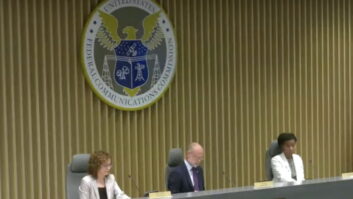This is one of a series of columns from the Society of Broadcast Engineers, published regularly in Radio World.
In early 2011, the shortage of commonly used IPv4 Internet protocol addresses reached the public media when the Internet Assigned Numbers Authority, the international body that allocates IP address space, depleted its pool of available addresses assigned to the five Regional Internet Registries, or RIRs.
The Asian-Pacific RIR subsequently depleted its pool of available IPv4 address space. In the United States, observers say the American Registry for Internet Numbers (ARIN) may exhaust its available IPv4 address pool as early as January 2013, though more optimistic projections cite 2016.

IPv6 was brought forward in the public eye as the solution for the dwindling availability of Internet address space.
At times, the address space shortage was considered an approaching Internet technology crisis. This may be true in some cases; but to many the “crisis” was nonexistent. In reality, the majority of North American network infrastructures are not ready for a “hot” cut to an IPv6-only mode of operation.
Many organizations have enough public IP address space or have met needs via dynamically assigning address space within their organizations. This resolution creates an attitude that “IPv6 is a possible future issue; however, it is not an issue today.” ARIN has IPv4 address space available and allocations are made based upon meeting the allocation and utilization rules of established ARIN policy.
However, this attitude can result in a certain sense of false security. The industry focus centers upon address space within an organization’s network; but shouldn’t the focus also be directed toward the broadcaster as a content provider and how the broadcaster is viewed by the Internet community?
From an international standpoint, the growth areas in terms of content consumers — “eyeballs and ears” — will be in an IPv6-only environment. This is especially true in the Asia-Pacific area, which is experiencing massive growth in Internet service demand. Growth is occurring in an IPv6-only environment simply due to lack of IPv4 address resources.
In the United States, because large blocks of IPv4 address space are not available, broadband cable and mobile data networks rapidly are moving to IPv6-only context to accommodate projected growth. ARIN has IPv4 address space to allocate, but not in the large block space desired by these providers. In addition, they are getting a jump on the future by implementing IPv6 now rather than later.
In either case, available IPv4 address space is decreasing as demand for Internet address space increases rapidly.
Fresh perspective
So what about this false sense of security for the broadcaster?
Instead of looking at your network from the inside and focusing solely on adequate IPv4 address space, look at your network from the outside. Who are the “eyeballs and ears” that desire your content? You will find the majority are IPv4-based content consumers; but at the same time, you may find a growing number of IPv6-only content consumers.
Evaluate when IPv6 implementation is needed by determining how the consumer has access to the content. Implement the network infrastructure that allows access in a native IPv6 format for the IPv6-only viewer and/or listener.
Technical solutions exist to accommodate the mixed world of IPv6-only consumers and IPv4-only content. Industry solutions include IPv6-IPv4 Network Address Translation (NAT) and, in many practical implementations, double NAT processes occur through solutions such as Carrier-Grade Nat (CGN).
IPv6 Quick Facts
IPv4 Address Space:
Slightly over 4,000,000 IP Addresses Available
IPv6 Address Space:
340,282,366,920,938,463,463,374,607,431,768,211.456 IP addresses available
(340 undecillion or 3.4×1038)
But, IPv6 is more than just larger address space:
— Security (IPsec) incorporated
— Designed with QoS in mind
— Has awareness of mobility
— Restores the end-end Internet communications model
For some types of Internet content, such as basic Web page content, these solutions are viable. However, a major drawback of any solution is the detriment to Quality of Service (QoS) factors that affect real-time media content, such as streaming audio and video content provided by the broadcaster or similar audio and/or video content providers.
Enabling
What is the solution for the broadcaster?
If you are a provider of content to the Internet audience, IPv6-enable your network to the outside world. In practical terms, enable your content servers, Web servers and external email so that your content or service is provided in native form to both IPv6 and IPv4-only consumers.
This approach eliminates the need for any translation or conversion schemes, thus eliminating the potential for performance degradation. A proactive approach also prepares you for the future sooner than later.
Enable your “outward-facing” network services in an IPv4-IPv6 “dual-stack” mode, which allows your content to be delivered in a native format to both IPv4 and IPv6 “eyeballs and ears,” and lets you provide the best possible listening or viewing experience for your content consumers.
IPv6 may not be on your technology roadmap today, but as you look to the future, be sure to survey the Internet content consumer world from the proper viewpoint so that your “roadmap” is reflective of the changing technology and consumer. Take the implementation road that provides the best possible experience for your content consumer. This just might be your competitive advantage.
For more information regarding IPv6 implementation, consider attending the SBE webinar to be offered this spring. It will focus upon implementing IPv6 as suggested. Visit the Education page on sbe.org for more details about the webinar.
Wayne M. Pecena, CPBE, is a member of the SBE Education Committee and a speaker for the SBE on networking technology at Ennes Workshop events and the SBE sponsored webinars. He is director of engineering at Educational Broadcast Services in the Office of Information Technology at Texas A&M University. Email [email protected].






